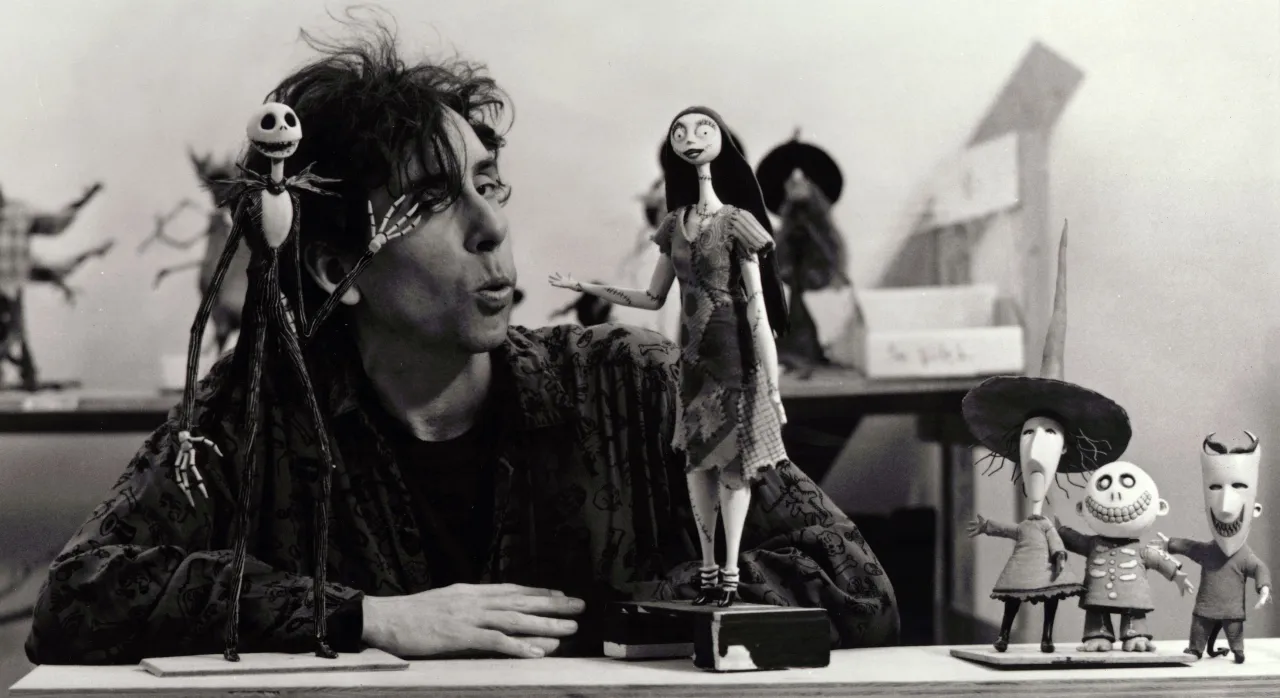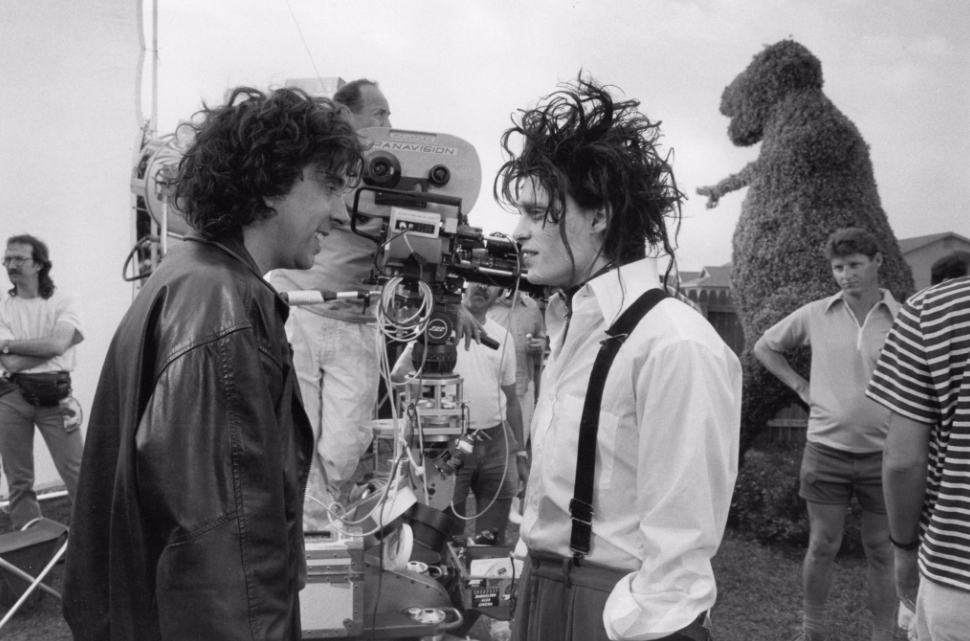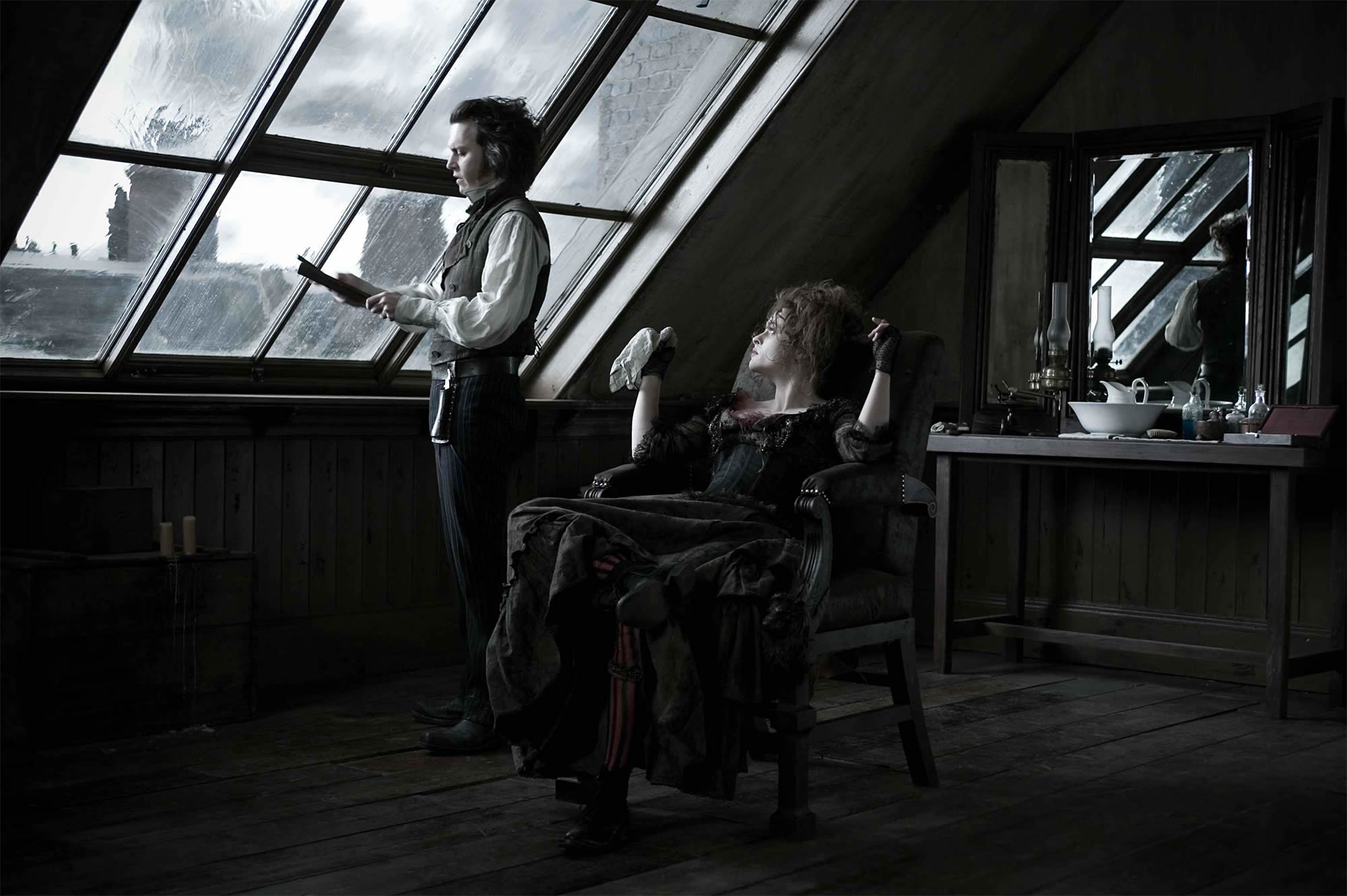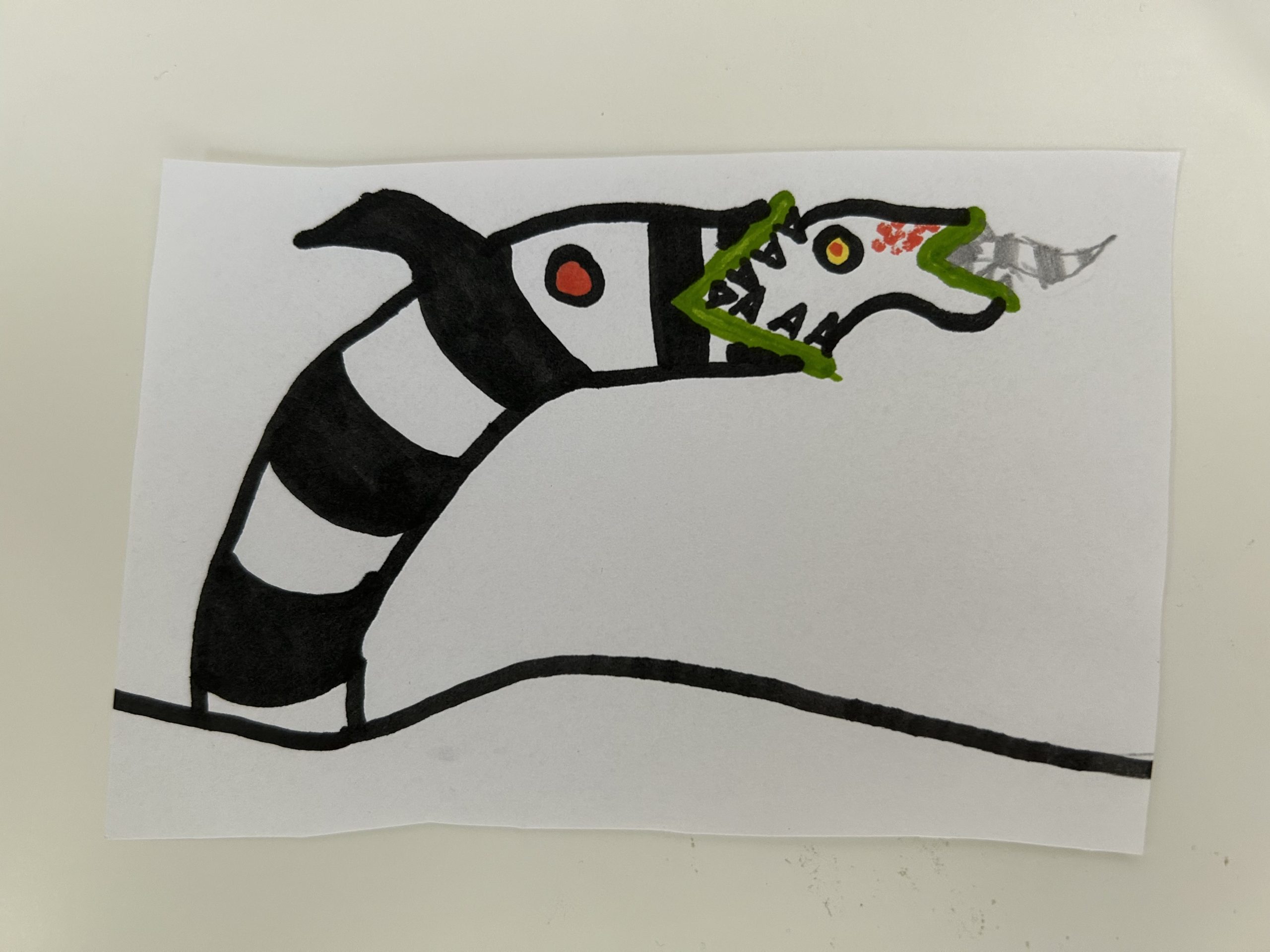Tim Burton – The Puppet Master Is Back Among the Living
The camera glides over a seemingly quiet provincial town, accompanied by a lively soundtrack composed by Danny Elfman. Somewhere up on the hill is a house of impossible, or at least impractical, architecture. Inside, distorted proportions, dramatic colours and shapes contrast with the characters’ garish, haute couture costumes. Chances are they have exaggeratedly large eyes, pale white skin, and scars that, upon closer inspection, are actually stitches. They move freely between reality and what lies beyond but don’t seem at home anywhere because they are neither alive nor dead. You’re most likely watching a film by the prolific Tim Burton, whose style has made him one of the most popular and easily recognizable directors of recent decades.
However, in 2024, the release of a new Tim Burton film is no longer seen as an event. It’s debatable when the decline began: some point to the inexplicable remake of Planet of the Apes (2001), the first film in his career where he suppressed all his creative impulses, while others point to the plunge into the pixel sea that is Alice in Wonderland (2010), guilty (with over $1 billion in box office revenue) for rekindling Disney’s annual frenzy of live-action reinterpretations of its animated classics. Meanwhile, his films continue to be marketed as coming straight from the “visionary mind of Tim Burton”, but where does his cultural imprint fit in today?
Before answering this question, we need to take a brief look back.
Vincent
The ideal introduction for anyone wanting to trace the red thread that connects Tim Burton’s filmography is Vincent, a wonderful 6-minute stop-motion short film made while the young director was working as an animator at Disney in 1982. From the story, told in rhyming verse, of a 7-year-old boy who imagines himself living in Edgar Allan Poe’s universe and embodying actor Vincent Price (who narrates the film), Burton would channel narrative themes and visual elements into much of his work over the next 40 years: the misfit protagonist with a hidden dark side (Vincent is nice when his aunt comes to see him / But imagines dipping her in wax for his wax museum), who views the world from the outside and feels at home in the company of monsters: the revived dog (Frankenweenie), the dead bride (Beetlejuice, Corpse Bride). The sources of inspiration for his well-known style are also already established – the German Expressionist films of the 1920s, the Hammer Studios gothic horror films of the 1950s, Cold War-era sci-fi and fantasy B-movies, Roger Corman’s adaptations of Poe, and the prototype characters played by Vincent Price in them.
After Vincent and the 1984 medium-length Frankenweenie (his live-action debut), Hollywood came knocking.
The Golden Era
There are few comparisons in American cinema for the uninterrupted string of successes (at least creatively, if not always at the box office) that Burton had between 1985 and 1994, working exclusively on projects close to his sensibilities.

From Pee-wee’s Big Adventure (1985), a meta-pastiche in an absurd key inspired by Bicycle Thieves, and his first collaboration with composer Danny Elfman, Burton moved on to Beetlejuice (1988), the film through which the wider audience truly became acquainted with the eccentricity that became his directorial hallmark.
Adam (Alec Baldwin) and Barbara (Geena Davis) die in a car accident – despite driving a Volvo – and their spirits become trapped in the house where they had been living. When the Deetz family (Charles, a real estate tycoon, his artist wife Delia, and their daughter Lydia) moves in, the two new ghosts decide they can’t coexist with the new residents. Luckily for them, a demonic chaos agent, self-titled “bio-exorcist” Betelgeuse (Michael Keaton, out of control in a gonzo role that’s now legendary), offers to help them, for a hefty price. Creative – featuring a detailed, carefully stitched, colourful plot – utterly unpredictable, and starring Winona Ryder as a goth teen, in a striking performance that made her a star, Beetlejuice has no equal.
Batman (1989) and its sequel, Batman Returns (1992), brought superhero movies back on track after the disaster known as Superman IV (which, given today’s cinema guides, I’m not sure we should be thankful for), bringing goth back to Gotham. Between these films came another cult classic, Edward Scissorhands (1990), a touching suburban fairy tale that marks the first collaborations with Johnny Depp and costume designer Colleen Atwood, and the final project of Vincent Price, Burton’s idol.
Although not directed by him, but by the underrated Henry Selick, Tim Burton’s The Nightmare Before Christmas (1993) and its main character, Jack Skellington, claimed by all generations of pre-teens on both Halloween and Christmas, are some of Burton’s most recognizable creations. He co-wrote and produced the animation based on a poem of his from the ’80s. Today, it’s one of the films that sells the most merchandise related to Burton’s name.

Ed Wood (1994), an unusual project due to its conventionality, is a love letter to Edward Wood Jr., considered one of the worst filmmakers in history (whose Plan 9 from Outer Space and Glen or Glenda are charmingly inept), to the B-movies of the 1950s that marked Burton’s childhood, and to another of his idols, Bela Lugosi (played by Martin Landau, who won an Oscar for the role).
The Dark Era
With Mars Attacks! (1996), a new homage, this time to the Cold War-era alien invasion films that thrived on paranoia, the puppet master irreversibly enters the era of computer-generated effects. It produced a few highlights (Sleepy Hollow, a playful reinterpretation of the Headless Horseman legend; two stop-motion animations that seem pulled from his personal archives of the 1980s: Corpse Bride and Frankenweenie; and a gory musical, Sweeney Todd: The Demon Barber of Fleet Street) and plenty of misfires: a couple of tepid melodramas, Big Fish and Big Eyes; a few self-pastiches with a plastic aftertaste: Charlie and the Chocolate Factory, Dark Shadows; and some Disney series products: Alice in Wonderland and Dumbo. With each film, Johnny Depp’s and/or Helena Bonham Carter’s makeup gets thicker, and the viewer’s wonder is lessened.
Among these projects, one stands out as it marks a transition to the young adult phase of his career: Miss Peregrine’s Home for Peculiar Children (2017). From there, it was just a step to Wednesday (2022).
A New Generation
Among all the films of the ’90s that owe their existence to the success of Beetlejuice, the best known are The Addams Family (1991, dir. Barry Sonnenfeld) and its sequel Addams Family Values (1993), with their macabre humour and gothic atmosphere, adaptations of a comic strip in The New Yorker that also inspired Burton (see the possessed hand in Vincent). Thirty years later, as we live in the world of streaming platforms where success is measured in the hundreds of millions of minutes watched and everything that was once old is new again, Netflix greenlit Wednesday, starring the youngest member of the famous family (played by Christina Ricci in the films and Jenna Ortega now), and hired Tim Burton to direct several episodes. Nostalgia is irresistible, and the algorithms know it.

Countless memes, teen t-shirts, and viral moments later, Wednesday (with its mix of vampires, werewolves, gorgons, and other fantastic creatures) became one of Netflix’s most-watched products, and Tim Burton is back in the spotlight, this time among Generation Z. His formula is unchanged but spreads faster online: for example, Wednesday Addams’ dance scene isn’t very different from Lydia’s (Winona Ryder) dance at the end of Beetlejuice, but this time, everyone is watching it simultaneously.
And so we come, after a long detour, to Beetlejuice Beetlejuice (2024), a legacy sequel that reunites Burton, Danny Elfman, Jenna Ortega (starring as Lydia’s daughter, of course), the writers and at least one of the storylines from Wednesday, along with actors from the original film 36 years ago.
This time around, Delia (Catherine O’Hara) and Lydia (Winona Ryder) return to the haunted house for a funeral and some administrative matters, only to once again come face-to-face with the demon Betelgeuse (Michael Keaton), who still wants the same thing: to escape into reality. A few new characters, in varying states of decay, haunt their steps.

Completely chaotic (I dare you to understand how the transition between our world and the afterlife works) and packed with more storylines than it can handle, Beetlejuice x2 dials back on the CGI and returns to elaborate makeup effects (especially the tortured undead) and the signature sandworm, which looks like it’s crocheted from a sock pattern. Keaton improvises as if he teleported back three decades, Justin Theroux – who should be in every movie – and Catherine O’Hara seem to be having a summer camp blast, and Burton has finally rediscovered his long-lost childhood toys in the treehouse, along with the affection for characters that, back in the day, wasn’t stifled by artifice. Until proven otherwise, he is back among the living.
It will be interesting to see what he does next with this newfound popularity, especially among generations who didn’t grow up with Johnny Depp’s films. For season 2, Wednesday has moved its filming location from Romania to Ireland, but Burton remains the director for a few episodes. After that, he’ll collaborate with writer Gillian Flynn on a remake of Attack of the Fifty Foot Woman (1958). Another project for which he seems the obvious choice, without pushing his limits. As long as he stays away from Disney, it should be fine.
Beetlejuice Beetlejuice hit theatres on September 6.
Dragoș Marin published articles and film reviews on filmreporter.ro and colaborated in various specialized festivals and TV shows. In everyday life he's a prokect manager while continuing to stay connected to pop culture and to write about what he has to say.


